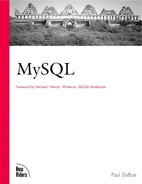mysqlbug
Chapter 2 of the MySQL Reference Manual contains a detailed procedure for filing a bug report. Following that procedure helps ensure that your report will be helpful and will contain sufficient information to resolve the problem you're reporting. A key part of this procedure is to use the mysqlbug script. It's used to create and send a bug report to the MySQL mailing list when you discover a problem with MySQL. mysqlbug gathers information about your system and MySQL configuration and then drops you into an editor containing the contents of the mail message to be sent. Edit the message to add as much information as you can about the problem you are reporting, and then write out the message to save your changes and exit the editor.mysqlbug will ask you whether or not to send the report and then mails it if you confirm.
Please use mysqlbug to report bugs, but don't use it lightly. In many cases, a "bug" isn't a bug at all or is a report of something that has already been documented in the Reference Manual. For example, it's been reported as a bug several times that the statement DELETE FROM tbl_name reports a rows-affected value of zero. That's true, but it's the intended behavior. It's also documented in the manual as such, as is the query to use instead if you want the true count. The MySQL mailing list archives are another useful source of information. Links to these can be found at http://www.mysql.com/doc.html.
Usage
mysqlbug [address]
The bug report is sent to the MySQL mailing list by default. If you specify an email address on the command line, the report is sent to that address instead. You can specify your own address to try out mysql bug without sending the report to the mailing list; that's not a bad idea when you're first using the script and are perhaps not quite sure how it works.
